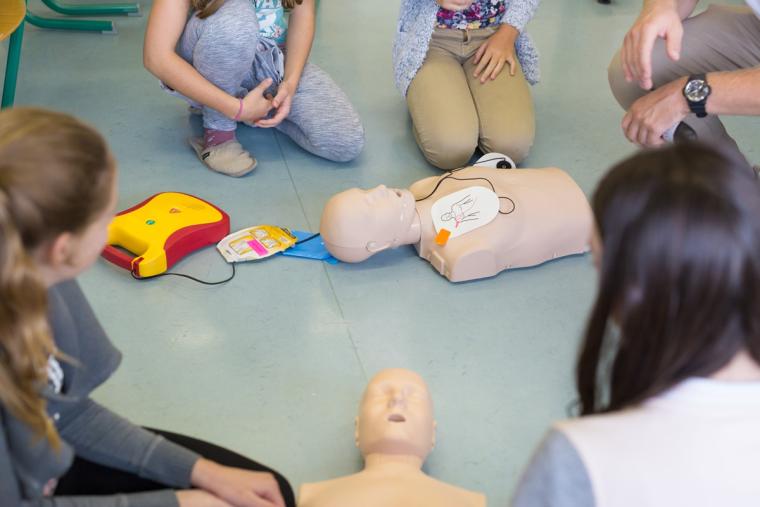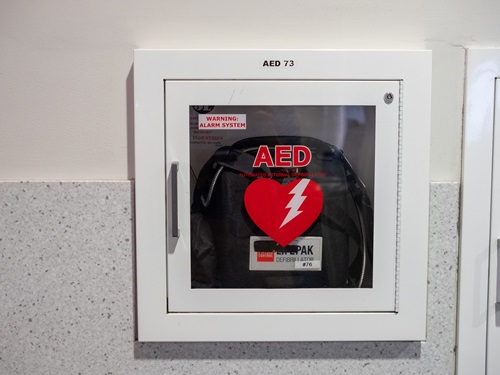
One year after Buffalo Bills safety Damar Hamlin suffered cardiac arrest on the field at Paycor Stadium in Cincinnati on Monday Night Football — and six months removed from the sudden cardiac arrest suffered by Bronny James, son of the NBA’s LeBron James, during a summer workout — a congressman from New Jersey has introduced federal legislation to combat sudden cardiac arrest in young athletes.
The Cardiomyopathy Health, Education, Awareness, Research and Training in Schools (HEARTS) Act, introduced by U.S. Rep. Frank Pallone Jr. (D-N.J.), would require the Secretary of Health and Human Services to coordinate with the Centers for Disease Control and Prevention, patient advocacy groups and health professional organizations to develop educational materials and resources on cardiomyopathy for public awareness and to distribute materials to schools, teachers and parents. It also calls for guidelines regarding the placement of automated external defibrillators in schools, along with information on CPR training.
“All too often, otherwise healthy young people die tragically from sudden cardiac arrest — a silent killer that strikes too many students each year,” Pallone said in a statement, citing CDC estimates of 2,000 people under the age of 25 dying each year from cardiac arrest. “It’s critical that we raise awareness about the causes of sudden cardiac arrest and ensure schools are more prepared to deal with cardiac emergencies so we can prevent these tragic deaths.”
“Despite recommendations that AEDs be placed in all schools from the scientific community and health organizations like the American Heart Association, the laws on AED requirements for schools vary widely from state to state,” according to the website for AED supplier Avive. “Some states have mandatory AED school laws, requiring AED placement and widespread training, while others have less stringent policies or leave it entirely up to the school management’s discretion. Out of 50 states, less than half have requirements for the installation of AEDs on school campuses.”
 Last March, Congress introduced the Access to AEDs Act, bipartisan legislation that would “require the Department of Health and Human Services to award grants to local educational agencies (LEAs), including public charter schools operating as LEAs under state law, to promote student access to defibrillation in elementary and secondary schools.”
Last March, Congress introduced the Access to AEDs Act, bipartisan legislation that would “require the Department of Health and Human Services to award grants to local educational agencies (LEAs), including public charter schools operating as LEAs under state law, to promote student access to defibrillation in elementary and secondary schools.”
“An estimated 350,000 people in the United States experience sudden cardiac arrest outside of the hospital each year, and 1 in 300 youth has an undetected heart condition that puts them at risk. Having community members trained in CPR, making AEDs available in schools and encouraging schools to develop emergency response plans will make schools better prepared to respond to sudden cardiac arrest and save lives,” Nancy Brown, CEO of the American Heart Association, said at the time the bill was introduced. As of early 2024, Congress had not acted on the act.
In the meantime, state lawmakers are taking matters into their own hands, passing AED and CPR laws — many spurred by the sudden cardiac arrest deaths of young athletes in their jurisdictions.
Alabama’s Sudden Cardiac Arrest Prevention Act went into effect this school year, mandating all school coaches to receive CPR and AED training every two years. Coaches and athletic trainers also must give preseason presentations to their student-athletes about the signs, symptoms and treatment of sudden cardiac arrest. Failure to follow the required training and protocols will result in loss of their position.
“This bill is really to protect the athlete and make the coaches aware that this is very prevalent in today’s society, and you’re going to see it,” State Rep. Jeremy Gray, who sponsored the bill, told Alabama Public Radio. “I didn’t see it much growing up, or through my athletic career, but we’ve seen it more recently, each and every day.”
He went on to liken the prevalence of sudden cardiac arrest in young athletes to concussions.
“For a long time, we didn’t know how prevalent concussions were, how often athletes got concussion or [their] long-term effects,” Gray said. “Sudden cardiac arrest is the same thing. For the majority of the world, this is something new.”
While sudden cardiac arrest is the leading medical cause of sudden death in young athletes in the United States, Black athletes appear to be at a higher risk, researchers say.
“Understanding why among all athletes, Black players have higher rates of sudden cardiac arrest is an important public health issue and should be an urgent focus of future research,” Jonathan Kim, director of sports cardiology and associate professor of medicine at Emory University in Atlanta, told the National Heart, Lung, and Blood Institute in October. “What we’re seeing now is not necessarily a new trend or new uptick in cases,” explained Kim, “Black individuals tend to have higher rates of sudden cardiac arrest and sudden cardiac death compared to White individuals in the general U.S. population. The trend toward those higher rates in Black athletes mirrors that disparity.”

